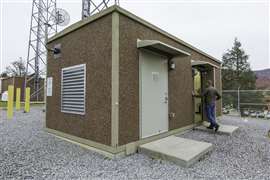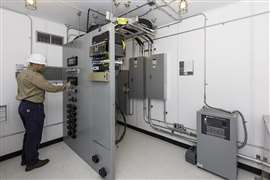Heavy weather: Climate change drives demand for storm-resistant, bullet-proof cabins
15 October 2024
An increasing number of extreme climate events such as Hurricane Helene in the south east USA are driving demand for highly weather-resistant cabins protecting vital communications equipment. Lucy Barnard speaks to Scott File, CEO of Virginia-based VFP which manufactures them.
 Asheville, NC, USA; Debris litters the area surrounding the Swannanoa River during the aftermath of flooding caused by the remnants of Hurricane Helene. Photo: Nathan Fish-USA Today/ Reuters
Asheville, NC, USA; Debris litters the area surrounding the Swannanoa River during the aftermath of flooding caused by the remnants of Hurricane Helene. Photo: Nathan Fish-USA Today/ Reuters
In Asheville, North Carolina, search crews with dogs continued to wade through sludge looking for survivors from one of the deadliest storms ever to hit the USA.
US President Joe Biden, vice president Kamala Harris and former president Donald Trump all travelled to the region to witness the rescue efforts which were being hampered by severe road damage and outages of power, internet and phone signal.
“God willing, they’re alive,” said Biden as he took an aerial tour of storm-ravaged western areas of the state. “But there’s no way to contact them again because of the lack of cell phone coverage.”
Two hour’s drive away in Roanoke, Virginia, Scott File, chief executive of VFP, a small construction firm which specialises in manufacturing robust concrete cabins, says Hurricane Helene is acting as a wakeup call to service providers across America looking to protect electricity substations, data centres and other communications networks in the event of a growing number of extreme weather events.
“The hurricane did masses amounts of damage and almost in our backyard,” he says. “They are hurting very badly, and we’ve gotten phone calls from all different industries that we serve asking what we can do to get product to that area as quickly as possible.”
 A typical VFP concrete cabin. Photo: VFP
A typical VFP concrete cabin. Photo: VFP
File says that VFP started off in the 1960s using fiberglass to protect buildings from rain and wind, but since the 1990s has carved a niche for itself making increasingly weather and violence-resistant concrete shelters aimed at keeping power and communications networks functioning in extreme conditions. The employee-owned company, which has a staff of 430, sells more than five hundred cabins a year both within the US and around the world.
“Our buildings are very rugged. They have got a two-hour fire rating. They are bullet resistant – so they will stop a 30-06 rifle fire at 15 feet. They’ve got a 160 mile an hour wind rating,” says File. “We can raise them up to prevent water intrusion, so we have cabins we have installed on a flood plain. You walk into one of these and they are super solid.”
VFP cabins retail at anything from US$100,000 to ‘many’ millions of dollars depending on the specifications. High spec cabins include power distribution, air conditioning and lighting and sometimes the complex electrical components which go inside.
“We have recently developed a building that is compliant to an EF5 tornado which is winds of over 200 miles an hour,” says File. “They tested it by shooting a 16 pound two by four [piece of wood] at it at 100 miles an hour and it did not sustain any damage. You could see cosmetically where it put a blemish on the wall, but it did not penetrate it.”
And he says, VFP is increasingly marketing its cabins on their possible use as a refuge for people during extreme weather events or outbreaks of violence.
Increasing demand for refuges
”Most of our sites are unmanned once they are operational, but sometimes there are people working there. Sometimes too we’re the first product to roll onto a construction site where more buildings are planned. If a tornado comes up and there are people working on site, this gives personnel on site a safe haven to go to,” he says. “When things start getting heated up in the world like the way they are now unfortunately, then sometimes that calls for increased demand on our product as well.”
VFP is far from alone in the construction industry catering to an increase in demand for climate resilient structures with manufacturers of storm shelters, bomb shelters and safe rooms across the USA reporting big increases in sales over the past decade. State-wide investment into flood protection programmes and securing roads and water supplies is also increasing.
The reason is clear: According to accountancy firm BDO, in 2023 alone the US experienced 28 separate climate disasters, each costing at least US$1 billion and totalling US$92.9 billion in damages – representing a 21% rise in the number of billion-dollar disasters since 2020 and a 35% increase over the last decade.
 A concrete cabin is delivered by truck. Photo: VFP
A concrete cabin is delivered by truck. Photo: VFP
The Netherlands-based Global Commission on Adaptation estimates that an overall investment of US$1.8 trillion in climate resilience measures in buildings, infrastructure and land could unlock benefits worth US$7.1 trillion until 2030.
And as more and more industries start to put in place resilience plans to protect their businesses from extreme weather events, VFP says its customer base is becoming increasingly diverse.
“I would say that in the 60 years of the company, demand is at an all time high,” File says. “More applications are coming on. It’s essentially any industry that has equipment that needs to be protected from the environment.”
“This is for customers who are putting in some gear that they expect to be operational for thirty or forty plus years. It could be telecommunications, it could be the data centre market, it could be public safety, it could be the utility market, and we sell some to the military. If you go to all this trouble to set up the gear and somebody can take it down easily or it can be destroyed in a storm, then it compromises your system.”
Data centre market drives demand
“The data centre market is driving a lot of need for our product. We’ve done some of those projects ourselves but what we typically see is they’ll have one big data centre and then that customer’s building may have perhaps thirty, forty, fifty modules that go outside the data centre and have the backup power systems. And then there’s a substation that’s being built to power the data centre so they tend to feed off each other.”
And this is not just a US trend, File says, VFP has sold buildings in all 50 states of the United States, as well as in 82 countries around the world and on all seven continents.
 Cabin interior. Photo: VFP
Cabin interior. Photo: VFP
The company can even boast two cabins operating in Antarctica which house satellite uplink stations.
“We had to make some special adaptations there because of the frigid temperatures,” says File. “There were concerns over things like door gaskets – something as simple as that can break down in freezing temperatures.”
To meet these strict specifications, cabins are manufactured in their entirety at VFP’s Virginia factory and then delivered by truck or ship to the customer – or occasionally flown by military helicopter - where they are installed onto a pre-laid concrete base.
“The customer pours the foundations so you’ve got a concrete slab and at eight in the morning they set up a crane and by the time you’re ready to go to lunch the buildings are sitting there together and the crane is breaking down and leaving the site,” says File. “There’s a lot of craziness of construction goes out of the way when you’re working in our controlled space at our factory verses working out at a site.”
CONTÁCTESE CON EL EQUIPO





